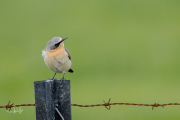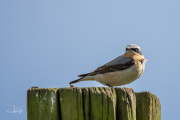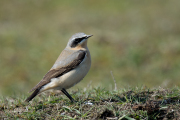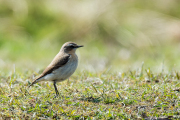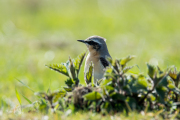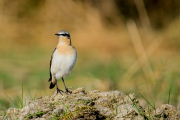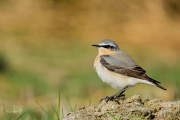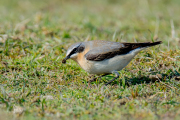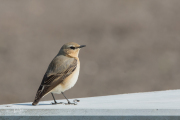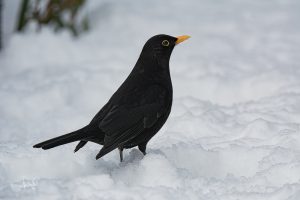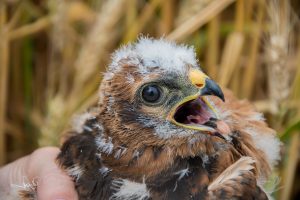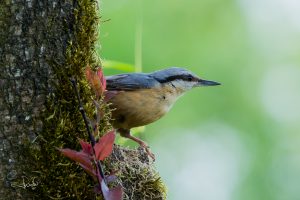Upside-down T
In my youth, a bird I would often see foraging in the fields when I was cycling to and from school, was the northern wheatear (Oenanthe oenanthe). This was a bird typical of agricultural lanscapesand nowadays as a breeding bird it has almost disappeared in the Netherlands. The male bird has a beautiful gray back and a black mask, the female a bit more discrete in color. But they both have that characteristic upside-down black T on their white tail, which is visible in flight. The wheatears you see in the Netherlands in spring are almost all migrants, coming from their wintering area on the African savannas and on their way to Scandinavia, sometimes to the far north. They can migrate over distances up to 15,000 kilometers.
Ripe grape
The explanation of the scientific name Oenanthe goes back to Greek antiquity. It comes from “oine” in the meaning of vine. The ancient Greeks gave this bird the name oinanthe because of the isabel-coloured (pale yellow-white) haze of chest and throat, which could remind one of a ripe grape. And Linneaus could not stay behind and gave the bird the scientific name Oenanthe oenanthe. The English name wheatear has its origin in the end of the 16th century. It comes from white-ears, literally meaning “white-arse” for its white colour of the anal region and its uppertail coverts.
Insect eater
The wheatear is a real insectivore. You can see this in its fine pointed beak. Its diet includes beetles, caterpillars, flies and spiders. But grasshoppers are also on the menu. The wheatear uses both its sight and hearing when foraging. Mostly they stand on an elevated point, for instance a molehill or a clump of grass, and keep a close eye on their environment. When it spots its prey it will run from its vantage point and suddenly stop and peckits prey from the upper soil layer. They can move fairly quickly due to their long legs.
Downhill
I remember that in my youth I often saw them on a sandy land reclamation site near my home village. Such habitat is ideal for this bird, which also successfully nested there. In recent decades, this site unfortunately has been increasingly converted into an industrial area. The sandy plains have been used as motocross track for years. And the wheatear has disappeared. So where you used to see wheatears much more frequently about forty years ago, now you have to be lucky to see one. As with so many bird species, the wheatear is not doing very well. In Europe it is even one of the fastest declining species. In the seventies there were more than 2000 breeding pairs in the Netherlands, now the number is estimated at a maximum of 250. It is therefore listed as threatened on the Red List. The chance of survival of the youngsters is relatively small, only 80% of the 5-6 eggs per brood hatch and only 3 youngsters per breeding pair per year survive.
Various causes
This decline has various causes. One of the main causes is the disappearance of habitats due to a decline in the area of suitable heathland and the vegetation succession in the dunes that causes open spaces to overgrow with shrubs. Because a wheatear needs open, sandy places to look for their food and to breed. The bird has no business in areas that are overgrown with grasses and herbs. And of course predation by other bird species and by mammals also plays a role.
Depending on rabbits
But there is another reason to mention: the decline of the rabbit population (Oryctolagus cuniculus). The wheatear likes to breed in rabbit holes and we all know that this mammal is also not doing well. The rabbit has practically disappeared from the agricultural landscape and with it the wheatear disappeared as a breeding bird. In the dunes on the North Sea coast and on a few of the Wadden Islands there are fortunately some breeding populations. But also in some sandplains inland, such as the Dwingenderveld in the province of Drenthe. Several of these areas are also protected as Natura 2000 areas, in the hope of turning the tide for rabbits, wheatears, and many other species. If it’s not too late already …
Bronnen:
This post was originally published in Dutch on April 28th 2017



